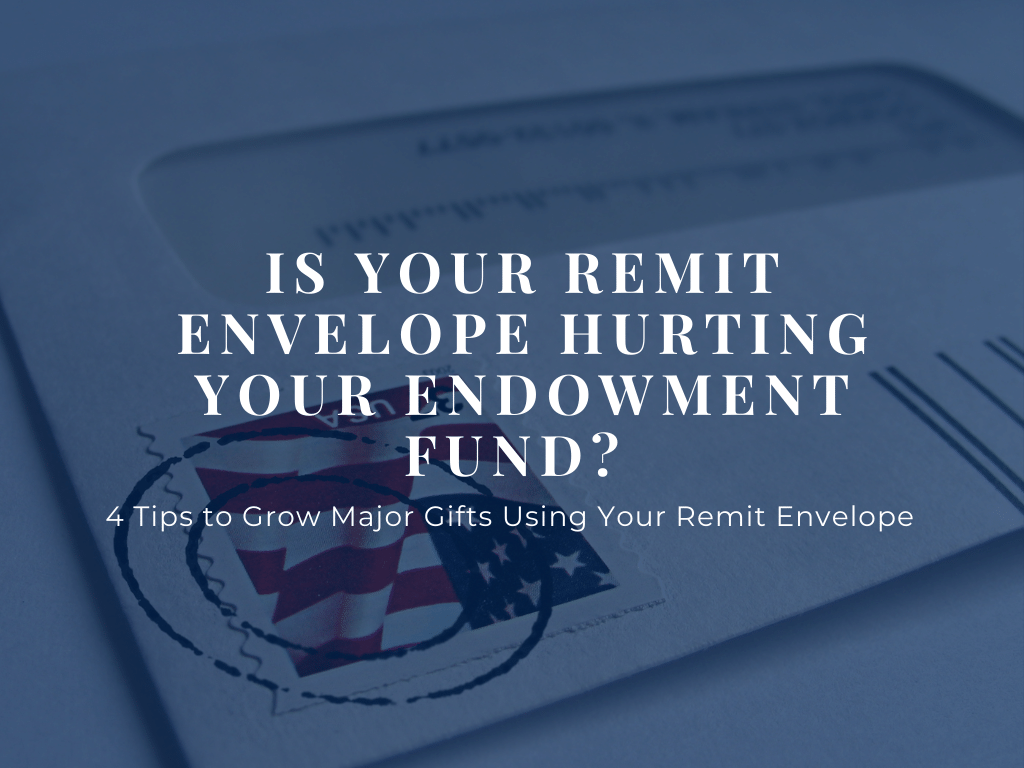
You spend hours designing an eye-grabbing outer envelope for your direct mail appeal to increase the chance of being opened. Then you spend even more time crafting your appeal letter, pulling on emotions with your heart-warming story and creating a problem the donor wants to help solve.
But you never receive a donation.
What happened? Why are so many of your donors not converting after being moved by your appeal? The answer could be your remit envelope.
Just like the outer envelope’s job is to entice the donor to open your piece of mail, the remit envelope has the critical job of inspiring the donor to send it back with a big check. Sometimes the appeal letter was thrown out weeks ago, and the only thing that remains is the remit envelope. If it is confusing, illegible, or not direct, they will get distracted and not follow through. If it is generic and vague, they will forget what it is for, and it will end up in the recycling bin.
You can use the remit envelope to highlight a specific program or fund you would like to increase contributions towards. Highlighting your endowment fund on your remit envelope is a great way to raise awareness about the fund and grow direct gifts. Many major donors do not know about the different options they have to make a gift, and it is up to you and your remit envelope to educate them.
Here are four tips to grow your nonprofit endowment fund using your remit envelope.
Add a Checkbox With an Option to “Restrict Donations to ___ Fund”
Have pre-filled giving levels and add an option for donors to restrict their donation towards your nonprofit endowment fund. Many donors don’t know they have the option to direct their financial contributions to a specific area and enjoy the freedom of choosing a specialty program or fund.
When communicating with major donors, you want to customize the experience as much as possible. If you can, select pre-filled gift options that relate to their last gift. If a donor has given $25,000 every year, they should not receive a remit envelope with auto-filled gift amounts of $50, $250, $500, and $1,000. Adjusting the suggested amounts will maximize total gifts and remind donors of their giving levels. It is also helpful to have personalized gift strings or tailored giving levels associated with the donor’s giving history.
Another way to promote major giving is to include offering an option to join your legacy or honoree society if you have one associated with your endowment fund. Even if a donor chooses not to check the box, it may be the first time they have seen your endowment fund mentioned. Planting a seed is the first step!
Keep It Simple for Donors to Complete
It seems obvious, but many nonprofits ruin their remit envelope by making it illegible or messy. If it is difficult or confusing for a donor to complete the donation, it will never make it in the mail back to you. People have short attention spans, so make it as easy and straightforward as possible for somebody to complete the gift process.
We know it can be tempting to try to collect a lot of data from your donor, but this is not the place. Use follow-up communications and email surveys to further the relationship and get to know the donor better. For now, just focus on one thing: getting that gift!
Make sure the font on your envelope is large enough and in a dark, legible style. Allow plenty of space for donors to write their information (whoever is inputting donor information into your CRM will thank you!). Better yet, have pre-filled envelopes with custom donor information, so all they have to do is make the payment and choose the amount.
Refer to Your Endowment Fund Landing Page for Further Information
Mention the ability to find out more information online and ensure it is easy to access your Endowment Fund or Planned Giving landing page. Your website landing page is a great starting point for donors who have never been introduced to your endowment fund. The contact information for the appropriate development employee should also be prevalent.
Make it very easy for a donor to reach out for more information however they choose. Do you have space for a QR code? That would make it easier to go directly to the appropriate landing page and even be segmented and tracked.
Include an Option to Be Contacted for More Information
Some people don’t want to make the initial effort and would like you to reach out to them. Include an option that donors can select that notifies you to contact them about a special donation. It is beneficial to mention different types of gift options to get the donor’s mind turning. You could use a statement like, “I would like to be contacted about a special gift, such as a donation of stock, donor advised fund, planned giving, or endowment fund.” Educating donors on the options to donate noncash assets and making it as easy as possible will maximize your revenue.
The advisors at Carnegie Investment Counsel know how confusing and frustrating it can be to donate or move non-cash assets. Planning, coordinating, and executing a donation such as this is time consuming and sometimes complex. Contact Carnegie today to speak with an advisor about options to donate these unique assets and what tax-related benefits apply to you.
Bonus
If you plan on highlighting your Endowment Fund on your remit envelope, you can prep the donor by mentioning it in your appeal letter. Feature a problem the people you serve are facing and describe how the income from your Endowment Fund helps to solve it. You can also add a P.S. and remind people they can be in control of their contribution by designating it to your Endowment Fund. Calling attention to the impact your Endowment Fund makes on the people you serve will help increase direct gifts.
A direct mail campaign is a great way to engage with donors and build relationships. Your remit envelope helps ensure the donation makes its way to your mailbox by educating donors and creating an easy to complete the process.
A financial advisor at Carnegie Investment Counsel can help lighten your workload by being a financial and investment guide to your organization when these major gifts and noncash assets begin rolling in. We'll guide you through each step and be a resource for you and the donor. Contact Carnegie today to speak with an advisor about your organization's investing and endowment management needs.
Looking for a Financial Advisor for Your Nonprofit?
If you are currently looking for help with financial planning, contact us. We are happy to schedule an introductory meeting at your convenience.



